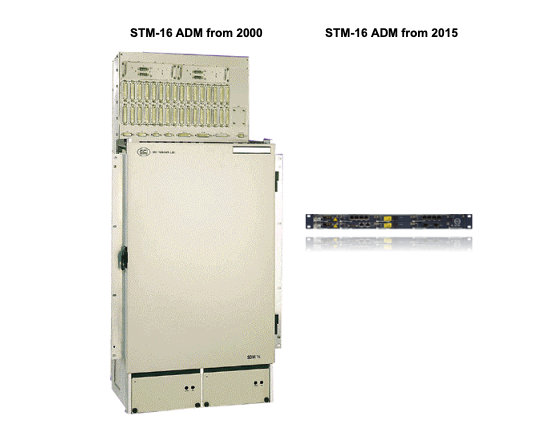SDH Past, Present, and Future: Planning Your Migration from Legacy Networks
Synchronous Digital Hierarchy, it died years ago, didn’t it? No. This is not an attempt to resurrect a retired technology, more a review of what SDH did for us (and in some cases is still doing).
Legacy SDH Networks: Strengths, Weaknesses, and the Case for Modernization
Little service visibility, no integrated resilience in transport, non-standard multiplexing and non-standard interfaces. No standard way to multiplex to higher speeds. No interworking between different vendors systems.
There was also a need to save hardware, integrate management and recognise the importance of timing. Application Specific Integrated Circuits (ASICs) offered a technical option which SDH (and SONET) took complete advantage of.
SDH (and SONET) were standardised towards the end of the 1980s. 1990 onwards saw the rapid development of equipment and capability. SDH added overheads to the services allowing them to be monitored, it included protection mechanisms for the services: hop by hop and end to end. SDH provided paths for network management and included resilient management of timing distribution.
One of the key hardware elements of SDH was the add-drop multiplexer, able to efficiently extract, from a high-speed signal, a low-speed service. The sub 50msec protection switching of SDH still ‘haunts’ transmission systems.
For the transport of telephony services: 2Mbit/s (1.5Mbit/s for SONET); and the PDH multiplexes: 34Mbit/s (45Mbit/s); and 140Mbits SDH excelled. Along with optical fibre, SDH delivered exceptionally low error rates for national and international distances. Previously, data services, like X.25, needed to perform error checking and resend every hop. Now Frame Relay and ATM could assume error free transmission and let higher-level protocols request retransmission for the rare errored frames.
SDH facilitated high-speed data connectivity.
SDH Today: Operational Challenges and Coexistence with Modern Networks
SDH was not designed to carry Ethernet. Next Generation SDH arrived at the turn of the century.
Three standards gave SDH the ability to flexibly carry Ethernet:
- GFP: Generic Framing Protocol provides a standard way to adapt higher-layer client signals, such as Ethernet, for carrying over a transport network;
- VCAT: Virtual concatenation solves the problem of flexible bandwidth provisioning by creating variable bandwidth virtual pipes in an SDH stream. The traffic stream is split across multiple SDH flows that can follow multiple paths across the network. Earlier contiguous concatenation required the flows to follow one path across the network; and
- LCAS: Link Capacity Adjustment Scheme enables the hitless increase or decrease of the capacity of a virtually concatenated container in an SDH network.
Together these three standards facilitated the standardised mapping of Ethernet (and other data formats) into SDH.
One of my favorite images is of how technological progress in IT results in the shrinking of equipment. As an example The pictures below show a first-generation STM-16 add-drop multiplexer from 2000 and the same capability in a 3rd generation add-drop multiplexer from the last decade.

The Demise of SDH
Even before 2000, Ethernet transport was breaking out of the local area network (LAN) and into the wide-area network (WAN). Partly because SDH was seen as expensive, whilst Ethernet was cheap and partly because SDH was designed primarily for 64kbit/s voice, whilst data rates were Mbit/s, and above, and growing fast.
SDH rates peaked at 10Gbit/s (STM-64), faster speeds were possible but the largest container (C-4 at 150Mbit/s) began to be too small for core networks. At the same time the much larger data industry decided it would be better (cheaper and more efficient) to transport Ethernet as Ethernet rather than mapping it into SDH.
Initially, this was a disaster because LAN Ethernet did not have the mechanisms for WAN deployment. Once carrier-class Ethernet standards emerged (adding operations, administration, maintenance (OAM) and timing) to Ethernet the deployment of SDH declined.
Operating SDH in the Modern Era: Costs, Complexity, and Finding Efficiencies
Like all legacy (profitable) technologies SDH continues to be used in many networks delivering reliable managed transport, investment is low in SDH for networks and close to zero in SDH equipment. However, there are still replacements, maintenance and occasionally new deployments.
SDH maintenance is driven by users with traditional interfaces on expensive equipment where changing the interface is not an option. Or by users familiar with SDH but unable, and often not needing to, invest in the cost of a new network.
However it is harder and harder to get the basic SDH parts and, in just a few years, new SDH equipment is unlikely to be available.
There are several options:
- Buy large numbers of spares and maintain your network for as long as possible;
- Invest in a packet network with TDM interfaces circuit emulated. One of the many improvements in Ethernet transport has been the development of MPLS-TP. The transport profile of MPLS avoids all the complex bits like uni-directional paths, point to multi-point operation and the paths are provisioned from centralised management. With appropriate OAM signalling (Bi-directional Forwarding Detection (BFD)) MPLS-TP also duplicates and can even exceed sub-50msec protection switching;
- Go the whole way and move completely to a packet network with all services packet based. IP/MPLS can be configured to deliver the equivalent resilience and deterministic behaviour of SDH if that is required. Soon segment routing promises to deliver the dynamic performance of IP/MPLS and the resilience of MPLS-TP in a simpler manner with source based routing; or
- Combine the above. Gradually migrate legacy services using circuit emulation to a packet network. Gain experience in the performance of MPLS-TP or IP/MPLS. Modify interfaces where possible to a native packet format. As services on SDH decline withdraw equipment but keep it as spares for the remaining SDH.
Where Are We Now
SDH is still beloved (certainly by those of us whose career grew in parallel) and responsible for much of critical infrastructure communications. It will continue to fade but, like all transmission technologies, be around for decades to come.
Packets are here to stay and can do everything any operator needs.
Ribbon's Solutions: Enabling a Smooth Transition from Legacy SDH Infrastructure
Ribbon recognises each user of a transport network has unique needs. Within our Neptune family, we can mix and match support of SDH, Ethernet and MPLS-TP services. Or we have pure packet switches with Ethernet, MPLS-TP, IP/MPLS and segment routing. Circuit emulation for sub E1 to STM-4 is supported. We offer all these options to ensure the migration from TDM to packet is as smooth as possible and takes place at the time and pace you want.
One lesson I take from the success and then decline of SDH is it was probably too good, like tarmac on the road, you only notice it when it’s broken, and SDH rarely broke.
Find out more about our MPLS services for your SDH


